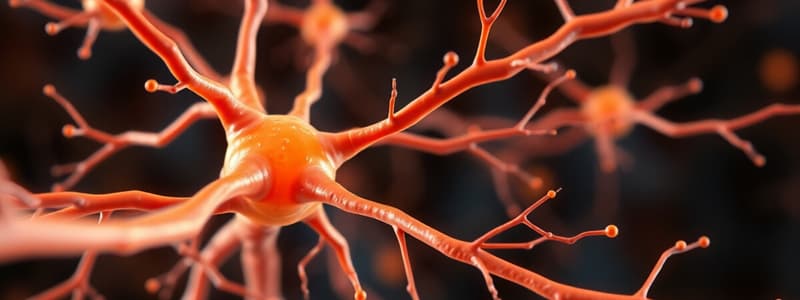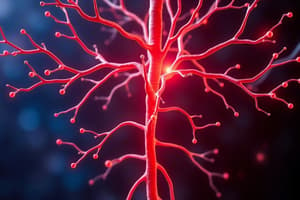Podcast
Questions and Answers
Which enzyme is responsible for hydrolyzing acetylcholine into acetate and choline?
Which enzyme is responsible for hydrolyzing acetylcholine into acetate and choline?
- Pseudo-cholinesterase
- Calmodulin
- Acetylcholinesterase (correct)
- Vesicular transporter
What triggers the release of acetylcholine from nerve terminals?
What triggers the release of acetylcholine from nerve terminals?
- Opening of sodium channels
- Diffusion of calcium ions (correct)
- Binding of acetylcholine to receptors
- Diffusion of potassium ions
Which type of cholinergic receptor is primarily associated with smooth muscle contraction?
Which type of cholinergic receptor is primarily associated with smooth muscle contraction?
- Nicotinic
- M2
- M5
- M3 (correct)
What is the composition of nicotinic receptors found at the neuromuscular junction in adults?
What is the composition of nicotinic receptors found at the neuromuscular junction in adults?
Which receptor type does acetylcholine activate primarily in the heart to open K+ channels?
Which receptor type does acetylcholine activate primarily in the heart to open K+ channels?
What is the role of the vesicular transporter (VAChT) in cholinergic fibers?
What is the role of the vesicular transporter (VAChT) in cholinergic fibers?
Which fiber type does norepinephrine NOT release to?
Which fiber type does norepinephrine NOT release to?
What effect does ACh have on muscarinic M2 receptors?
What effect does ACh have on muscarinic M2 receptors?
What characterizes cholinergic fibers in the autonomic nervous system?
What characterizes cholinergic fibers in the autonomic nervous system?
Which of the following is a characteristic of synapses in the autonomic nervous system?
Which of the following is a characteristic of synapses in the autonomic nervous system?
Which neurotransmitter is primarily released by cholinergic fibers?
Which neurotransmitter is primarily released by cholinergic fibers?
Which of the following fibers is involved in the sympathetic nervous system?
Which of the following fibers is involved in the sympathetic nervous system?
What is a function of choline acetyltransferase in cholinergic neurons?
What is a function of choline acetyltransferase in cholinergic neurons?
Which statement accurately describes the binding of neurotransmitters to receptors?
Which statement accurately describes the binding of neurotransmitters to receptors?
What is the primary action of drugs targeting the autonomic nervous system?
What is the primary action of drugs targeting the autonomic nervous system?
Which of the following statements about postganglionic sympathetic fibers is true?
Which of the following statements about postganglionic sympathetic fibers is true?
What is the primary source of tyrosine used in the synthesis of catecholamines?
What is the primary source of tyrosine used in the synthesis of catecholamines?
Which enzyme is responsible for converting dopamine to noradrenaline (NE)?
Which enzyme is responsible for converting dopamine to noradrenaline (NE)?
What mechanism primarily accounts for the removal of secreted noradrenaline from the synaptic cleft?
What mechanism primarily accounts for the removal of secreted noradrenaline from the synaptic cleft?
Which enzyme's activity is inhibited by cocaine and tricyclic antidepressants in the context of noradrenaline removal?
Which enzyme's activity is inhibited by cocaine and tricyclic antidepressants in the context of noradrenaline removal?
How is dopamine primarily transported to the vesicles for storage?
How is dopamine primarily transported to the vesicles for storage?
What is typically contained in the granulated vesicles alongside noradrenaline?
What is typically contained in the granulated vesicles alongside noradrenaline?
Which of the following is a function of phenylethanolamine-N-methyltransferase?
Which of the following is a function of phenylethanolamine-N-methyltransferase?
What is the predominant mechanism by which catecholamines are released from nerve endings?
What is the predominant mechanism by which catecholamines are released from nerve endings?
What is the primary mechanism by which drugs can manipulate autonomic activity?
What is the primary mechanism by which drugs can manipulate autonomic activity?
Which of the following drug actions can occur at the efferent autonomic pathway?
Which of the following drug actions can occur at the efferent autonomic pathway?
What type of drugs primarily affect the Parasympathetic Nervous System?
What type of drugs primarily affect the Parasympathetic Nervous System?
Which statement is true regarding sympatholytic drugs?
Which statement is true regarding sympatholytic drugs?
How can drugs influence the breakdown of neurotransmitters in the autonomic system?
How can drugs influence the breakdown of neurotransmitters in the autonomic system?
What is the primary action of norepinephrine (NE) when stimulated through α2 presynaptic receptors?
What is the primary action of norepinephrine (NE) when stimulated through α2 presynaptic receptors?
Which of the following receptors increases cAMP levels when stimulated?
Which of the following receptors increases cAMP levels when stimulated?
Which neurotransmitter is most closely associated with the response of dilating pupils?
Which neurotransmitter is most closely associated with the response of dilating pupils?
What physiological effect does clonidine exert on blood pressure?
What physiological effect does clonidine exert on blood pressure?
What is the function of catechol-O-methyl-transferase (C.O.M.T.)?
What is the function of catechol-O-methyl-transferase (C.O.M.T.)?
Which of the following is NOT associated with the sympathetic nervous system's alarm response?
Which of the following is NOT associated with the sympathetic nervous system's alarm response?
In terms of receptor distribution, where are β-receptors prominently located?
In terms of receptor distribution, where are β-receptors prominently located?
What effect does stimulation of β2 receptors generally have?
What effect does stimulation of β2 receptors generally have?
Flashcards are hidden until you start studying
Study Notes
ANS neurotransmitters, fibers and receptors
-
Synapses are junctions between neurons where signals are transmitted.
-
Chemical transmission is involved in autonomic synapses.
-
Cholinergic fibers release acetylcholine (ACh) and activate cholinergic receptors.
-
Adrenergic fibers release norepinephrine (NE) and activate adrenergic receptors.
-
Acetylcholine (ACh)*
-
Synthesis: ACh is synthesized from acetate and choline through a series of enzymatic steps.
-
Choline transporter (3) is inhibited by hemicholinium.
-
Choline acetyltransferase (1) catalyzes the synthesis of ACh.
-
Vesicular acetylcholine transporter (VAChT) transports ACh into vesicles.
-
Release: ACh is released by exocytosis triggered by Ca+2 influx.
-
Removal: ACh is broken down by acetylcholinesterase.
-
Cholinergic receptors: ACh activates two different receptor types:
- Muscarinic receptors (M1-5) are G protein-coupled receptors (GPCR).
- Nicotinic receptors are ligand-gated ion channels found in autonomic ganglia, CNS, and neuromuscular junctions.
-
Norepinephrine (NE)*
-
Synthesis: NE is synthesized from tyrosine through a series of enzymatic steps.
-
Tyrosine is transported into catecholamine-secreting neurons by a carrier.
-
Dopamine is produced by a series of enzymatic steps.
-
Vesicular monoamine transporters (VMAT-1 & -2), inhibited by reserpine, transport dopamine into vesicles.
-
Release: NE is typically released by exocytosis, along with ATP, chromogranin A, and β-hydroxylase enzyme.
-
Removal: NE is removed from the synaptic cleft by:
- Re-uptake: into the adrenergic nerve endings by an active transport process, inhibited by cocaine and tricyclic antidepressants.
- Diffusion away: from the nerve endings into the bloodstream.
- Destruction: by enzymes such as:
- Monoamine oxidase (MAO)
- Catechol-O-methyltransferase (COMT)
-
Adrenergic receptors*
-
Post-synaptic receptors:
- α1 receptors: increase IP3 and DAG.
- α2 receptors: decrease cAMP.
- β1, β2, β3 receptors: increase cAMP.
-
Pre-synaptic receptors: located on postganglionic adrenergic nerve endings and regulate neurotransmitter release.
- Stimulation of α2 receptors decreases NE release.
- Stimulation of β1 receptors increases NE release.
Alarm response
- Sympathetic nervous system activates as a unit during emergencies.
- Effects:
- Dilates pupils
- Accelerates heart rate, respiration, and blood pressure
- Constricts blood vessels in the skin
- Lowers threshold in the brain
- Stimulates lipolysis & glycogenolysis
Drugs that affect the autonomic activity
-
Drugs can manipulate neurotransmitter synthesis, storage, release, breakdown, reuptake or receptor binding.
-
Drugs that affect the Parasympathetic Nervous System:*
-
Parasympathomimetics: mimic or enhance parasympathetic activity.
- Acetylcholinesterase inhibitors: enhance the effects of ACh.
- Muscarinic agonists: directly activate muscarinic receptors.
-
Drugs that affect the Sympathetic Nervous System:*
-
Sympathomimetics: mimic or enhance sympathetic activity.
- Adrenergic agonists: directly activate adrenergic receptors.
- Indirect sympathomimetics: increase NE release or inhibit its reuptake.
-
Sympatholytics: block sympathetic activity.
- Adrenergic antagonists: block adrenergic receptors.
- Drugs that interfere with NE synthesis, storage, or release.
Studying That Suits You
Use AI to generate personalized quizzes and flashcards to suit your learning preferences.




